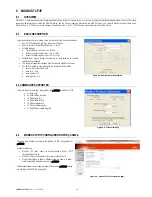
pCOWeb
+030220966 – rel. 1.1 – 12.12.2017
45
9.4
SETTING THE NETWORK COMMUNICATION PARAMETERS
For
pCOWeb
to communicate with the data network it is installed in, a number of network communication parameters need to be correctly set. The assistance of
the network administrator is required to establish if
pCOWeb
can be connected, and to understand the essential data relating to the installation. To better
understand the meaning of the procedure for setting these parameters, see APPENDIX A on page 58 and APPENDIX B on page 59. The following operations
are in any case possible even without having read the appendices. First of all, it must be established whether or not the network uses automatic address
setting (DHCP); ask the network administrator.
•
network with DHCP:
in this case
pCOWeb
is already ready in the factory configuration and no operation is required. The network administrator will
require documents that show the physical positions of the various
pCOWeb
devices and the corresponding MAC addresses (see 2.2 on page 10).To
check the setting of DHCP mode on the
pCOWeb
, follow the same procedure as described below for the “network without DHCP”.
•
network without DHCP:
in this case, before connecting
pCOWeb
to the network, the DHCP system, active by default, must be disabled, and a
different specific address entered for each
pCOWeb
. These procedures are described below.
9.4.1
Network configuration
This is the most important configuration. Without this, in fact,
pCOWeb
will
not be able to communicate correctly with the Ethernet network.
Starting by the main configuration page – Information (
Figure 9.b
on page
42), click “Configuration”, then click the “Network” tab (
Figure 9.j
).
The page shown in
Figure 9.k
sotto is displayed.
This page is used to set the following fundamental user network parameters:
IP address
NetMask
NOTE 1 The values set will be saved to non-volatile memory only when
selecting the “Submit” button.
IMPORTANT: The values set will only be used when
pCOWeb
is next
rebooted.
Figure 9.j - Opening the network configuration page
NOTE 2 If
pCOWeb
is started when the button is pressed (paragraph
3.1.2 on page 12), the “Bootswitch” settings will be used instead
of these values (see
Figure 3.g
on page 14).
SETTINGS AVAILABLE:
Eth0 (required)
•
For networks with automatic address setting (DHCP server), write
DHCP or dhcp or alternatively leave empty. The NetMask, if set, will
not be used.
•
For networks that do not use automatic address setting (DHCP),
enter the IP address and the NetMask established for this
pCOWeb
by the network administrator.
Make sure to use the correct format; examples:
10.0.3.114
255.255.0.0
without spaces.
APPENDIX A on page 58 and APPENDIX B on page 59 provide further
information on the meaning of the parameters.
Eth0:1 – Eth0:2 – Eth0:3 (optional): irrespective of whether the DHCP
method is used, up to a maximum of 3 other IP addresses can be set that
pCOWeb
will respond to; entering “DHCP” in these fields will produce no
result: Eth0 is the only parameter enabled for the activation of DHCP.
IMPORTANT: If Eth0 = DHCP, the addresses Eth0:1-Eth0:2-Eth0:3 will
only be operational when the server has assigned a dynamic IP and only
during its period of validity (called “lease”).
Gateway Address (not used with DHCP operation): used in cases
where notifications are to be sent in response to events (see 4.3 on
page 20).
Set the IP address for the Gateway in the subnetwork that the
pCOWeb
Eth0 IP address is part of.
NOTE The gateway configuration is not required if the address of
pCOWeb
and the receiving network devices belong to the same
subnetwork. For further information see APPENDIX B on page 59.
DNS servers: required only if the recipients of the notifications (e-mail
/ TRAP / FTP PUSH) will be specified not using IP addresses but
rather names (for example: “working_pc.net”).
Set the IP address of at least one server with Domain Name Server
functions. For further information see APPENDIX B on page 59.
Figure 9.k - Configuration - Network






























